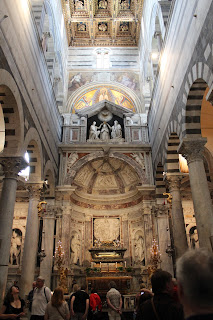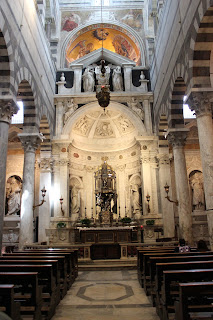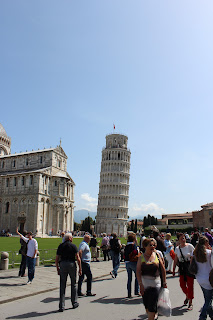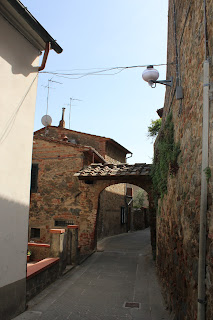The outdoor recreation center has a pretty fantastic list of
activities that people of the military community and their families and friends
can sign up for. PJ and I have signed up for several of them, including our ski
trip to Stubaier Gletscher and our snowshoeing trip. We have also reserved a
few other trips in June and July, including ones to Lugano, Portofino, and
Croatia.
On Saturday, May 4th, PJ and I traveled to Pisa and Vinci
for a day trip with outdoor rec. We began the trip at 6:30 am and arrived in
Pisa at around 10:30am. We arrived in the Piazza Dei Miracoli [a UNESCO World
Heritage Site] and had a brief tour of the Duomo, which was built in the Pisan
Romanesque style and began construction in 1093. The main architect was
Buscheto, but Rainaldo, Buschetos successor, designed the façade. Buscheto, the
main architect of the Duomo, is buried in the last blind arch on the left side
of the façade.
 |
| Looking down the nave of the Duomo. |
 |
| Coffer ceiling |
 |
| Giovanni Pisano's Pulpit |
 |
The crucifix is by Giambologna.
The apse showcases a mosaic
of Christ Pancrator. |
 |
Transept crossing with painted
oval dome. |
 |
| Tomb of Emperor Henry VII |
 |
| Cappella del SS Sacramento. |
We then viewed the exterior of the Romanesque Baptistery,
which began construction in 1152 and wasn’t completed for 211 years. This is
the largest Baptistery in Italy. The arches along the lower portion are
Romanesque [rounded], but the arches along the top are Gothic in design
[pointed].
 |
| Baptistery |
 |
| Baptistery entrance. |
 |
The left side of the portal depicts the 12 months,
while the right portrays the Apostles, the Harrowing
of Hell, and King David. |
A few of us then headed over to climb the Leaning Tower of
Pisa. They have made some modifications to the observation levels since 2008,
having added a chain link fence around the entire perimeter of the exterior. I was curious, and
it seems that a Dutch man jumped over the railing in 2011, which I am assuming
is the reason for the 7 or so foot fence around both levels now.
 |
| From the entry. |
 |
| I had to do it. |
 |
| PJ refused! |
 |
| PJ and I infront of the tower. |

Some fun facts about the Leaning Tower of Pisa:
+ It took over 800 years to complete.
+ It was actually straight for the first 5 years [when only 2
floors were complete].
+ There was a 100-year span when the construction was stopped
on the tower. This was because the engineers were hoping the clay would settle
and harden so the 14,500 ton tower wouldn’t lean.
+ Many people tried to “fix” the tower to correct the lean,
but to no avail.
+ During WWII American soldiers had orders to destroy the
leaning tower because they believed it had potential to act as “a potential
nest for enemy snipers”. Thank goodness they didn’t!
The leaning tower continues to lean around .2 inches
[1.25mm] a year, so it has fallen 1 inch since the last time I saw it; I hardly
noticed. The climb up is a strange sensation. The way the tower leans forces
the visitor to walk from the inside to the outside of the steps, which is
clearly marked by recessed indentations on the stone steps.
 |
| From the lower observation level. |
 |
The Leaning Tower was used as a
bell tower. It is lined with bells along the top. |

 |
| The leaning staircase. |
 |
| The core of the tower. |
Galileo and the Leaning Tower of Pisa
Galileo was born in Pisa. He later briefly attended school
and taught at the University of Pisa. Supposedly, one of his most famous
experiments was done from the top of the Leaning Tower. He dropped several
balls of different masses from the top of the tower and proved that, regardless
of their mass, all objects fall at the same rate.
I have found a few different variations of this story
online, so how much truth is behind it is uncertain, but an interesting story
nonetheless.
VINCI
Vinci, which is to the east of Pisa, was the next stop on
our day trip. It is a small town where Leonardo da Vinci was born, hence his
name Leonardo FROM Vinci. The first stop was a 30-minute walk to see La Casa
Natale di Leonardo; the house where Leonardo was born. It is an old farmhouse
overlooking olive groves and rolling hills. We did not tour the interior
because PJ and I wanted to get back to the main town to walk through the Museo
Leonardiano, but I believe there is a 2 euro cover to tour the house.
 |
| View from Leonardo's home. |
 |
Wild flowers along the trail to get
to Leonardo's home. |
 |
| Casa Natale di Leonardo. |
 |
| Casa Natale di Leonardo |
The next stopping point was the Museo
Leonardiano
, which is
a museum dedicated to Leonardo da
Vinci
and his work. The museum is broken into
2 parts, one being at the main museum in Palazzina
Uzielli
and the other inside
of the Castello
dei
Conti
Guidi
. The museum showcases things like building-site
machinery, textile manufacturing technology and mechanical clocks, while the
castle showcases machines and models of war based inventions, architecture,
flight, mechanics, optics, movement, etc… Photography wasn’t allowed within the
museum, but their website showcases a lot of mechanisms.
 |
| Town of Vinci. |
 |
| Town of Vinci. |
 |
| Still there after 5 years! |
 |
| The castle |
 |
| Town of Vinci. |
 |
| Vitruvian man. |
 |
| One of Leonardo's mechanisms. |
 |
| Ciao! |
After the usual Prosecco stop we headed home for the day. The
next morning was going to be another early day for our ODR wine tasting
adventure.







































No comments:
Post a Comment